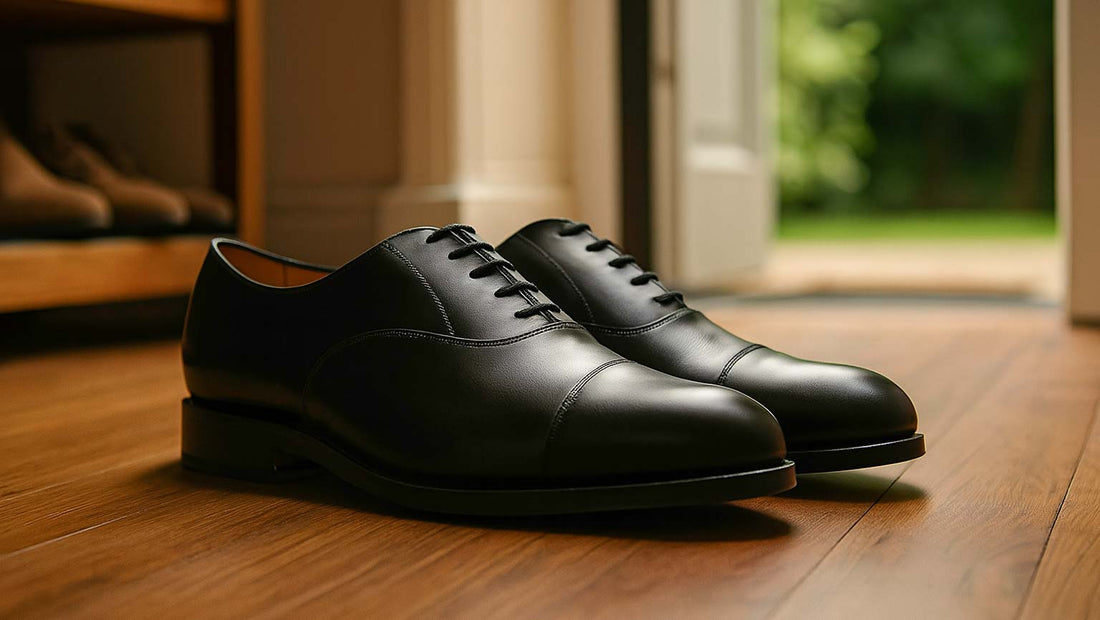
What Makes Goodyear Welted Shoes So Durable?
Share
What Makes Goodyear Welted Shoes So Durable?
Goodyear welted shoes have long been the benchmark for quality men’s footwear, especially in Britain. Built for durability, comfort, and ease of repair, they represent a time-tested construction method that sets them apart from cheaper alternatives. But what exactly is a Goodyear welt, and why is it so highly regarded? This article explains how the welt works, why it matters, and why discerning customers continue to choose this type of shoe.
What Is a Goodyear Welt?
The Goodyear welt is a method of shoe construction first industrialised by Charles Goodyear Jr. in 1869. It involves stitching a leather strip (called the "welt") to both the upper and a canvas rib on the insole. The outsole is then stitched to the welt — not directly to the upper.
This double-stitch method creates a strong, water-resistant seal and allows the sole to be replaced without damaging the shoe.
Why Are Goodyear Welted Shoes So Durable?
- Robust Construction: The triple-layer structure — upper, welt, and sole — means the shoe is structurally stronger than cemented or Blake-stitched shoes.
- Water Resistance: The stitched welt forms a tight seal, helping to prevent water from seeping through the sole.
- Repairable Design: Once the sole wears down, it can be fully replaced by a skilled cobbler without disturbing the upper.
- Retains Shape Over Time: The cork footbed moulds to your foot and holds structure well.
What Materials Are Used in Goodyear Welted Shoes?
High-end British shoes made in Northampton typically use:
- Full-grain calf leather
- Vegetable-tanned leather for welt and sole
- Cork filling for comfort and breathability
- Leather or natural-fibre linings
- Brass or waxed stitching thread
How Can You Spot a Goodyear Welted Shoe?
- Visible stitch line around the outside of the outsole
- Natural leather or quality rubber sole attached to a welt
- “Goodyear Welted” stamped on the insole or sole
- A firm structure that doesn’t collapse when squeezed
- Weightier feel than cheaper alternatives
Goodyear Welt vs Blake Stitch vs Cemented Construction
| Feature | Goodyear Welted | Blake Stitched | Cemented |
|---|---|---|---|
| Durability | Excellent | Moderate | Poor |
| Water Resistance | Good | Poor | Poor |
| Resoleability | Easy | Harder | Not possible |
| Comfort Over Time | Excellent | Good | Poor |
| Initial Break-In | Longer | Shorter | Short |
Why British Shoemakers Still Use This Method
In towns like Northampton, traditional manufacturers such as Sanders & Sanders, Tricker’s, and Crockett & Jones still use this method because it represents uncompromising craftsmanship. They cater to men who value longevity, proper fit, and style that doesn’t date.
Looking After Your Goodyear Welted Shoes
To get the most from them:
- Use cedar shoe trees to absorb moisture and maintain shape
- Polish with high-quality waxes
- Let them rest 24 hours between wears
- Store them away from heat sources
- Use a shoe horn to avoid heel damage
Conclusion: An Investment Worth Making
Goodyear welted shoes offer unmatched durability, comfort, and elegance. For men who wear smart shoes regularly — whether for business, weddings, or everyday style — they represent a smart investment. When combined with the right shoe care, accessories, and proper storage, these shoes can serve you faithfully for years and still look superb.
Founder of Cathcart Elliot Shoe Trees UK — passionate about quality shoes, shoe care and craftsmanship.
Read our full story →
